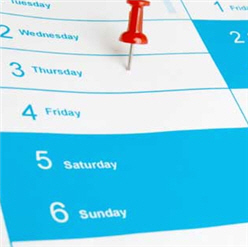How To Teach Days Of The Week


Once students have learned cardinal numbers, you will have to introduce ordinal numbers as well. This lesson should not directly follow the one on cardinal numbers because students need a lot of practice with those before being introduced to this topic however they are both beginner lessons and as such will most likely fall within the same school year. If students have had enough practice with cardinal numbers, this lesson should be fun and easy. You can use some of the same teaching materials and games too!
Warm up
Use the warm up activity to get students thinking about cardinal numbers especially if it has been a long time since you last practiced them. You can do this by using decks of number cards to play games like Memory or Go Fish in small groups or by playing a game such as Bingo as a class. To review more vocabulary, you can make up a story as a class instead. You can start by saying “I went to the store and bought one cat.” for instance, have the next student repeat your sentence and then add “and two ~.” and continue on until everyone has contributed. If you have a very large class, you may just want students to say a number and an item instead of repeating everything each time but this will give them less number practice.
Introduce Ordinal Numbers
Since ordinal numbers have nothing to do with amount but rather with position, do not start off by using numbers but instead use images of other vocabulary words to simulate a race on the board. You can talk with your students about the positions of each item by saying for example “The dog is first and the cat is second.” Begin with just a few words or images on the board and work your way up to give students practice using the first ten ordinal numbers. Introduce the word ‘last’ as well since this is a position related vocabulary word. Once students understand the meaning of these words, you can use number flashcards and choral repetition for pronunciation practice.
Practice
Using the same number cards as in the warm up activity, students can play games to practice these new words. Memory would be great for pronunciation practice as long as every student says the correct ordinal number aloud when he turns over a card. If students cannot be encouraged to actually say the words aloud, you may as well move on to another activity. You can use BusyTeacher’s ordinal numbers worksheets to test comprehension by asking students questions based on images or videos of races or lines. Students can also be prompted to write sentences about themselves such as “I am the first child in my family.”
Produce
To give students more speaking practice, you can provide them with a model dialogue or an interview activity. The model dialogue might focus on an image on the board where students take turns asking the position of various things and responding to questions. An interview activity could include questions such as “What’s the first thing you do in the morning?” or “What’s the first thing you do after school?” Your students’ range of vocabulary will help determine what questions are appropriate. Try to include a variety of previously studied material as well as different ordinal numbers even though first is probably the most commonly used.
Challenge
If your students are doing well, you can talk about the pattern of forming ordinal numbers. Make sure that students know that except for eleventh, twelfth, and thirteenth, numbers ending with one, two, or three are irregular and should be said first, second, and third respectively. You should also look at all multiples of ten from twentieth through ninetieth because these are pronounced slightly differently from other ordinal numbers. As with cardinal numbers students may confuse words such as thirteenth and thirtieth so these may require a round of Bingo of their own for extra practice.
Try to give students lots of fun practice activities in this lesson. There are not many occasions where ordinal numbers will come up in ESL classes except when talking about directions, for example “Turn left at the third corner.” and other instructions - “First preheat the oven.” where students will get lots of extra practice.